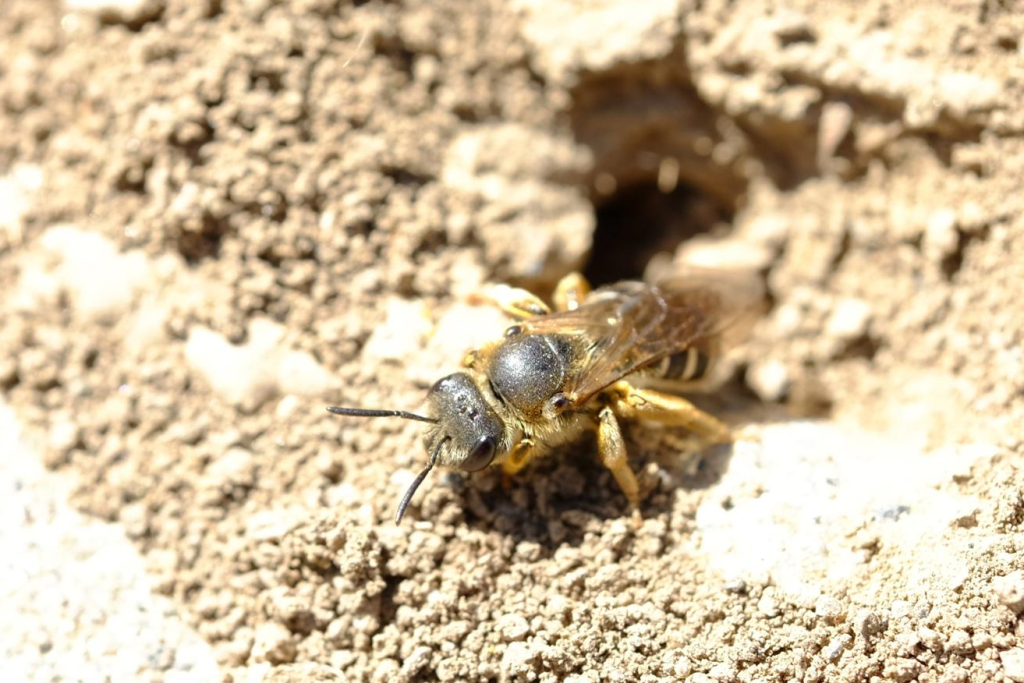Amelie Schmolke discusses recent work, conducted alongside colleagues, which involved the development of a trait-based model for solitary bees. Schmolke et al were able to model management scenarios and possible outcomes for bee species with incomplete trait data.
An introduction to bees
When thinking about bees, people often think of the honey bee. But there are over 20,000 species of bees in the world, most of which live a solitary lifestyle. They come in sizes between a few millimeters long to more than 2 cm, can have various colours and occur in most habitats across the globe.

Solitary bees generally collect provisions enough to feed a single offspring and seal it in a cell with an egg. The bees develop within the cell and only emerge from their sessile youth once the conditions in the environment are right. Where bees will nest is dependent on species, although the majority build their nests underground.
Stressors affecting populations
In agricultural landscapes, solitary bees are important pollinators of crops – with some species specifically managed for this purpose. At the same time, population dynamics over time are not well known for many species and bee diversity, as well as abundance, was observed to decline.
Multiple stressors may affect bee populations, for example:
- habitat loss resulting in lack of floral resources for foraging
- limitations of relevant nesting habitat
- potential pesticide exposures in treated crops
To better understand possible impacts of single and multiple stressors on solitary bees, we need appropriate methods and approaches.
Modelling via SolBeePop
We developed a trait-based model for solitary bees, SolBeePop, that can be used to simulate a range of species by specifying their trait values as model input parameters. The trait-based approach makes it possible to simulate multiple species with a single model and facilitates the exploration of possible outcomes of management scenarios for species with incomplete trait data.
Each species can be addressed separately, estimating population dynamics in a single season or over multiple years. The resource availability in the landscape as well as the weather inform the input to the model, allowing us to test different scenarios that could exert stress to a population. The model is implemented in NetLogo and publicly available.

We tested the model by comparing it to available data on one species – the red mason bee (Osmia bicornis). In the study, bees were introduced in “tunnels” of mesh set up above sections of flowering oilseed rape fields. Nest boxes were provided within the tunnels with cavities preferred by the species for nesting. The nest boxes could be opened without disturbing the bees’ nests, providing counts of actively nesting female bees and their production of provisioned brood cells every three days. Those data were compared directly to model outputs, and we demonstrated that the model captured dynamics of this experimental population very well.
Further, we applied the model to three additional species, the alfalfa leafcutter bee (Megachile rotundata), the alkali bee (Nomia melanderi) and the hoary squash bee (Eucera pruinosa). Because the trait values informing the model could be compiled from the literature, SolBeePop provides a tool to simulate population dynamics for species for which no corresponding data from field studies are available. Our analysis showed an interaction between the species’ traits and the population growth rate due density-dependence in nesting.
Future uses
The model can be applied to quantify vulnerabilities to stressors in a range of species. For instance, temporally limited floral resources can be simulated with the model and impacts to populations over multiple years can be assessed. Testing such scenarios relevant for the bees’ habitats, the model can inform improvements to bee habitats and advise management options to support the establishment and long-term sustainability of solitary bee populations.
Read the full article “SolBeePop: A model of solitary bee populations in agricultural landscapes” in Journal of Applied Ecology


One thought on “SolBeePop: A model of solitary bee populations in agricultural landscapes”